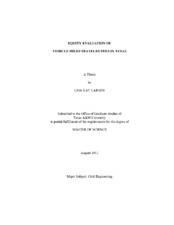| dc.contributor.advisor | Burris, Mark | |
| dc.creator | Larsen, Lisa Kay | |
| dc.date.accessioned | 2012-10-19T15:28:29Z | |
| dc.date.accessioned | 2012-10-22T18:02:07Z | |
| dc.date.available | 2012-10-19T15:28:29Z | |
| dc.date.available | 2012-10-22T18:02:07Z | |
| dc.date.created | 2011-08 | |
| dc.date.issued | 2012-10-19 | |
| dc.date.submitted | August 2011 | |
| dc.identifier.uri | https://hdl.handle.net/1969.1/ETD-TAMU-2011-08-9721 | |
| dc.description.abstract | The Texas state gas tax has been 20.0 cents per gallon since 1991, and the federal gas tax has been 18.4 cents per gallon since 1993. The gas tax is not only stagnant, but depreciating in value due to inflation. Thus, damage is being done to the infrastructure but the money needed to maintain and improve roadways is not being adequately generated. One proposed alternative to the gas tax is the creation of a vehicle miles traveled (VMT) fee; with equity being a crucial issue to consider. This research used 2009 National Household Travel Survey (NHTS) Texas data to consider the equity impacts surrounding four VMT fee scenarios. Data were filtered and weighted to reflect results representative of Texas vehicle-owning households in 2008. Each scenario was run both statically and dynamically under the assumption that the VMT fee would replace the state gas tax. An assessment of the relative vertical equity of each scenario was made by calculating the Gini Coefficient associated with the proportion of state gas tax or VMT fee revenue generated by each household income level quintile. Results indicate that all VMT fee scenarios are essentially as equally vertically equitable than the current state gas tax system. Scenario 4 was designed to be inherently horizontally equitable because the per mile fee associated with each roadway type (urban or rural) was assessed to all vehicles driven on these roadway types at a rate calculated to generate needed funds to address the mobility and infrastructure needs of that roadway type. Scenario 3, a scenario favoring vehicles with high fuel efficiency, was found to be the least horizontally equitable. Scenarios 2-4 were able to generate additional revenue desired to meet the infrastructure and mobility needs of Texas set forth by the 2030 Texas Transportation Needs Committee. The large fee increase necessary to achieve the desired additional revenue may not be popular or possible. However, an evaluation of the philosophy governing each scenario designed to generate additional revenue is informative when it comes to equity impacts. No one VMT fee scenario affects all household income levels and geographic locations uniformly and it was not the goal of this research to design an equitable VMT fee scenario. Rather, the effect of each scenario on 2008 Texas vehicle-owning households disaggregated by household income level and geographic location are presented and left to the discretion of elected officials to decide which VMT fee, if any, would be best for their constituents. | en |
| dc.format.mimetype | application/pdf | |
| dc.language.iso | en_US | |
| dc.subject | Vehilce Miles Traveled Fee | en |
| dc.subject | Gas Tax | en |
| dc.subject | National Household Travel Survey | en |
| dc.subject | Horizontal Equity | en |
| dc.subject | Vertical Equity | en |
| dc.subject | Static vs. Dynamic Model | en |
| dc.subject | Texas Infrastructure Needs | en |
| dc.title | Equity Evaluation of Vehicle Miles Traveled Fees in Texas | en |
| dc.type | Thesis | en |
| thesis.degree.department | Civil Engineering | en |
| thesis.degree.discipline | Civil Engineering | en |
| thesis.degree.grantor | Texas A&M University | en |
| thesis.degree.name | Master of Science | en |
| thesis.degree.level | Masters | en |
| dc.contributor.committeeMember | Hawkins, Gene | |
| dc.contributor.committeeMember | Pearson, David | |
| dc.contributor.committeeMember | Ellis, David | |
| dc.type.genre | thesis | en |
| dc.type.material | text | en |


